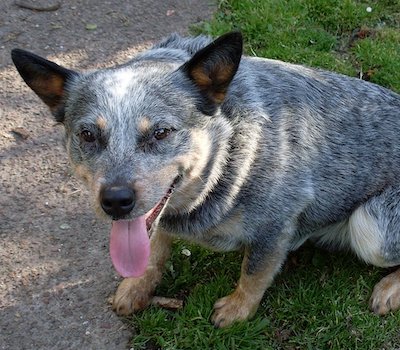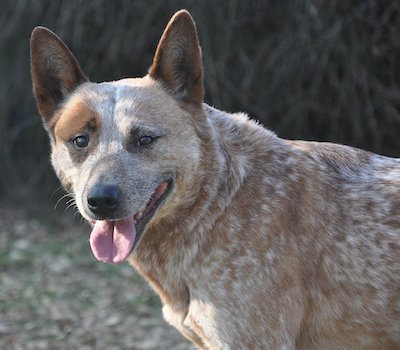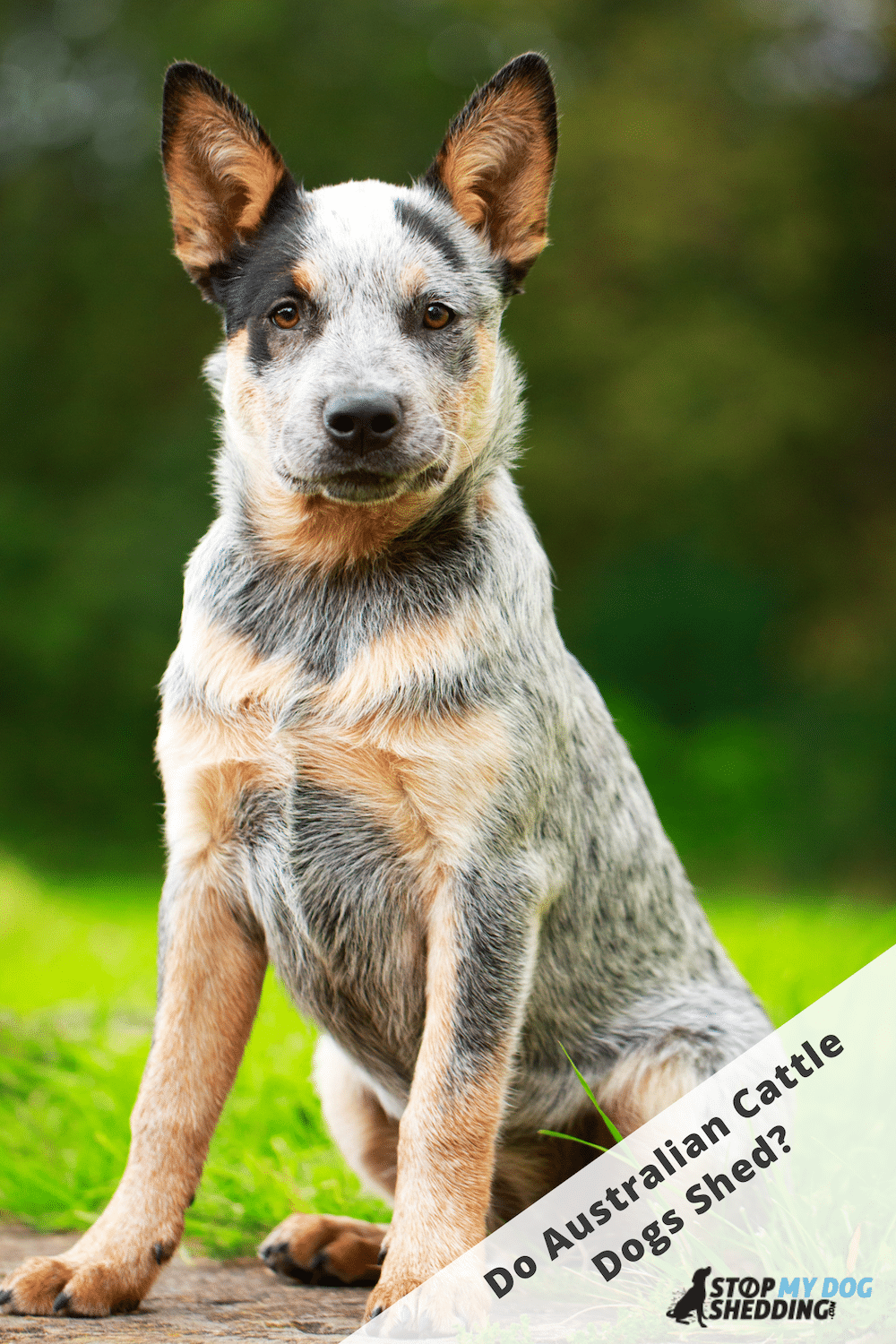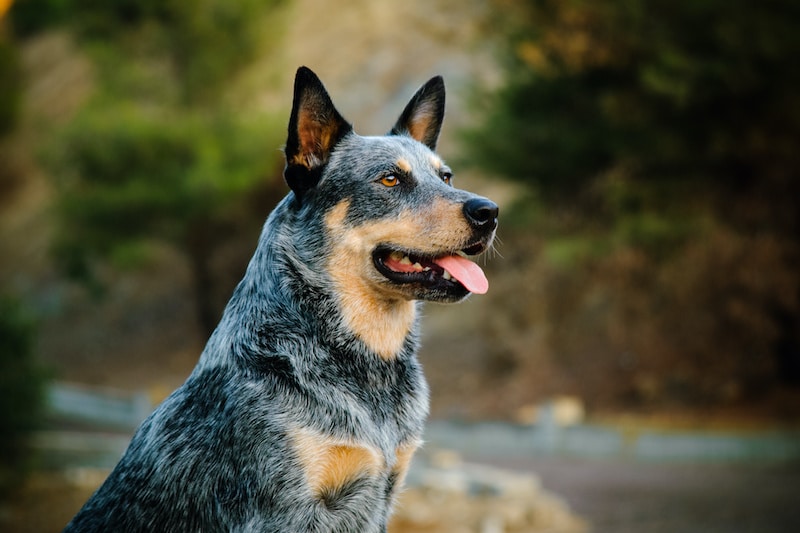Australian Cattle Dogs (AKA Blue Heelers) are dogs of medium size that were bred in Australia to herd and drive cattle. They are highly intelligent, energetic and eager workers on the farm, as well as loyal family companions.
Do they shed lots? Blue Heelers have a smooth double coat that sheds moderately, but the shedding can be quite heavy twice a year during spring and autumn when they “blow coat.” They’re rugged working dogs though, so maintaining their coat and removing the old, dead fur isn’t very difficult or time consuming.
In this article, we’ll take a closer look at how much ACDs shed, what it takes to maintain their coat, and how you can keep the molting to a minimum.
Recommended: Go here to see our top-rated dog hair blow dryers
Australian Cattle Dog Shedding
Australian Cattle Dogs are a moderate shedding breed.
Which means that, most of the time, you’ll notice some fur floating around the home, but not as much as you would with a heavy shedder like the German Shepherd or Labrador for example.
However, there are a couple of times each year when you may notice an increase in the shedding. And this is normally during seasons like spring and autumn when they “blow their coat.” The reason for this is because they are naturally preparing themselves for changing weather conditions.
For example, during spring they tend to shed their thicker winter coat because they no longer need this in the coming summer months.
See also: Do Australian Shepherds Shed Much?
It does depend on the individual dog and where they are located in the world, among other things, as to how extreme these yearly shedding events will be. But if you do notice an uptick in moulting for about 2-3 weeks come spring and autumn, this is likely the reason why.
There are other things that can cause dogs to shed beyond what is considered “normal” though. For instance, fleas, poor diet, allergies, hormonal imbalances and other types of health issues can cause excessive shedding. So if you do have any concerns, contact your local veterinarian.
Overall though, you should expect to notice some hair around the home with an ACD. Shedding is a normal and healthy process where they are losing the old fur to make way for the new batch. And getting this under control mostly comes down to proper grooming.
Recommended: Go here to see our top-rated dog hair blow dryers
Grooming Your Blue Heeler
Grooming a Blue Heeler isn’t difficult or time consuming.
They were bred as working dogs for the harsh conditions of Australia, so naturally don’t require lots of special attention when it comes to grooming.
For general coat maintenance, brushing once or twice a week with a slicker brush or bristle brush should do the trick. And since his coat doesn’t tend to have that typical dog odor, only the occasional bath is needed.
A slicker brush is a fairly common and inexpensive type of dog brush that is made of fine wire bristles that are slightly angled and have rubber or plastic tips on the end to protect the dog’s coat. And a bristle brush is a simple dog brush with bristles on it that come in either soft, medium or hard.
The reason these brushes are ideal has to do with his coat. ACDs have a smooth, double coat that is ideal for the Aussie conditions in which they originate. A double coat means that they have two layers of fur – an outer coat and undercoat.
The outer coat is made up of close lying, straight, hard guard hairs that are roughly one inch in length (except for some areas like the head, legs and feet where it tends to be shorter). And the colours of the coat are blue or red that is either mottled or speckled.
The undercoat is dense and close lying. And this, along with the rain-resistant outer coat, is what helps to insulate the ACD from harsh weather. Both hot and cold.
The fact that they have an undercoat is also why they tend to shed more heavily twice per year, and why it may be worth using a deshedding tool or undercoat rake during these times. Simply because these make removing the old, dead fur from the undercoat a bit easier and may save you some time.
Reducing Excessive Shedding
It’s not possible to completely stop Blue Heelers from shedding, but you can minimize excessive molting and limit how much fur ends up on your floors, furniture and upholstery.
The first method is simply to brush him regularly. You don’t want to over brush, to the point of causing skin irritation, but brushing several times a week during times of heavy moulting can make a big difference. And not just because it removes the dead fur from the source, but also because it helps spread his natural skin oils which is good for his coat.
The second method of reducing shedding has to do with bathing. ACDs don’t need to be bathed very often, but bathing more often during shedding season can help remove even more old fur from his coat.
Tip: Avoid bathing your dog too often or with harsh shampoos, as this can cause shedding due to dryness in the skin and hair. Use good quality dog shampoos that moisturise their coat.
Once you’ve got the grooming elements dialled in, the next thing to look at is what you’re feeding him, which is something your vet should be able to help you with. Basically, better quality dog foods reduce the chance of your dog shedding due to poor nutrition (a common factor in excessive shedding). And it can help him develop a healthy, moisture rich coat.
You don’t need to buy some sort of fancy dog food or supplement to stop shedding. But a healthy, balanced diet, can make a difference. Also, some find that natural supplements such as virgin coconut oil and olive oil are helpful.
Regardless of how good the dog food you select is, nothing is going to completely eliminate the shedding, but these simple things can make a difference overall. And if you want to learn about other ways to reduce shedding, check out this guide.
What Makes ‘Em Unique?
Australian Cattle Dogs are known as highly intelligent, energetic and hard working dogs that have a pleasant nature. They were bred to herd and drive cattle which is something they continue to excel at to this day.
There is some controversy over the exact origins of the Australian Cattle Dog. But according to the Australian National Kennel Club (ANKC) breed standard, they are the result of crossing smooth haired Collies with the wild Dingo and eventually, the Dalmatian.
Dingos are wild Aussie dogs, Collies are skilled herders, and Dalmatians were originally used as coach dogs, which made them confident around horses. Either way, crossing a Dingo, Dalmatian and Collie is one heck of a unique mix.
Aside from their origins, there’s also some varying opinions about the difference between blue and red coloured Australian Cattle Dogs, other than just the colour itself.
For example, some believe that red ACDs (AKA Red Heelers) have more dingo in them and are more aggressive than blue coloured ACDs (AKA Blue Heelers). However, there is no evidence to support this. And according to Wikipedia, dog author and breeder Noreen Clark has suggested that some of these claims are more likely based on opinion.


Either way, there’s no difference between a Blue Heeler and Red Heeler other than the colours. At least, not according to the breed standard. Either the Australian version (ANKC) or that of the American Kennel Club (AKC). Despite their various nicknames (ACD, Cattle Dog, Blue Heeler, Red Heeler and Queensland Heeler) they are one and the same breed.
Should you adopt one? Like any dog, it really depends on you and your circumstances as to how suitable he will be to adopt.
He’s probably not the most ideal dog if you can’t give him enough attention. Given his intelligence, he can become quite destructive if left alone for too long or if you don’t stimulate him enough. And they are not considered to be hypoallergenic either, which means they’re not the most ideal breed for allergy sufferers.
However, if you can give your Cattle Dog the attention he needs, and you don’t mind seeing a bit of hair around the home, he can not only make an excellent working and herding dog, but also a loyal family companion that is cherished by the whole family.













Please note: By submitting a comment using the above comment form, you confirm that you agree with the storage and handling of your data by this site as detailed in our Privacy Policy.